
About Pacific Office Interiors
At Pacific Office Interiors, Our mission is to create extraordinary spaces that people want to be in. We have the team and experience to tackle any space design project — inside or outside.
About Pacific Office Interiors

At Pacific Office Interiors, Our mission is to create extraordinary spaces that people want to be in. We have the team and experience to tackle any space design project — inside or outside.
The Best-in-Class Haworth Dealer in Los Angeles
We are a Best-in-Class Haworth Dealer for the 6th Time!
Very few Furniture Dealers can become Haworth Dealers, and even fewer can achieve excellence in design, quality and customer service to become a Best-In-Class Haworth Dealer, but Pacific Office Interiors has done it for the 6th time

The Best-in-Class Haworth Dealer in Los Angeles

We are a Best-in-Class Haworth Dealer for the 6th Time!
Very few Furniture Dealers can become Haworth Dealers, and even fewer can achieve excellence in design, quality and customer service to become a Best-In-Class Haworth Dealer, but Pacific Office Interiors has done it for the 6th time
Let’s Talk About Your Project
Pacific Office Interiors offers a full suite of services to bring any office furniture project to life — on time and within budget. Contact us to learn how we can support your next project.
Contract Furniture Services in Los Angeles
Whatever the goals for your project, our team has the skills and experience to help you reach them. Pacific Office Interiors can design, acquire, install and maintain everything needed for perfect new or renewed commercial interior and outdoor spaces. Although we are an Office Interiors Design and Furniture company based in Los Angeles, we regularly serve clients with offices all over California.

Commercial Interior Design Services
Your new office or interior space begins with imaginative commercial interior design. Our commercial interior design services shepherd you through each step of the process, each of which is “designed” to reflect your organization’s unique personality, style and mission.

Commercial and Contract Furniture Sales
As one of the most respected office interior design and contract furniture dealers in Los Angeles and throughout California, our Commercial and Contract Furniture Sales services rely on our partnerships with an exclusively curated selection of manufacturers. Companies that only sell through trained and well-respected dealers.
Our Clients RAVE About us. See what they say here:
Contract Furniture Services
Whatever the goals for your project, our team has the skills and experience to help you reach them. Pacific Office Interiors can design, acquire, install and maintain everything needed for perfect new or renewed commercial interior and outdoor spaces.

Commercial Interior Design Services
Your new office or interior space begins with imaginative commercial interior design. Our commercial interior design services shepherd you through each step of the process, each of which is “designed” to reflect your organization’s unique personality, style and mission.

Commercial and Contract Furniture Sales
As one of the most respected office interior design and contract furniture dealers in California, our Commercial and Contract Furniture Sales services rely on our partnerships with an exclusively curated selection of manufacturers. Companies that only sell through trained and well-respected dealers.
Industries We Serve
Pacific Office Interiors can help you with your interior and outdoor design projects no matter how the space is used, the industry you are in or where your project is located. Here are six examples of industries we have deep expertise serving.
Educational Institution Furniture and Interior Design

We can meet your needs for any project from K-12 to higher education, classroom to private spaces, interior and exterior.
Government Office Furniture and Interior Design

Government procurement practices are different and complex, but we know them inside and out for cities, counties, districts and states.
Healthcare Furniture and Interior Design

Our Healthcare expertise includes reception areas, front office spaces, back office spaces and exam rooms.
Hospitality Interior Furniture and Interior Design

Inside or out — when you want to impress and pamper your hotel, restaurant or lounge guests, we can help.
Corporate Office Furniture and Interior Design

We design spaces your employees will want to work in, your customers will love visiting and your colleagues will envy.
Work From Home Furniture

Working from home is here to stay. Let us help you equip your Work-From-Home staff for success, comfort and ergonomic support.
Contact Us to Get Started on Your Project
Pacific Office Interiors offers a full suite of services to bring any commercial contract furniture project to life — on time and within budget. Contact us to learn how we can support your next project.
Work From Anywhere and Third Places Furniture and Services
Modern offices of all kinds realize the importance of giving staff the freedom to work away from their desk…to work in third places or work from anywhere (WFA) of their choosing.

Work From Anywhere and Third Places Furniture and Services

Modern offices of all kinds realize the importance of giving staff the freedom to work away from their desk…to work in third places or work from anywhere (WFA) of their choosing.


